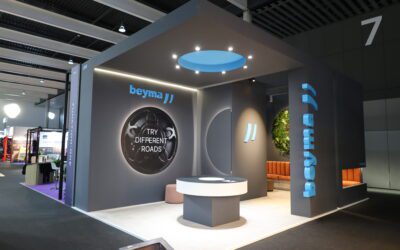Medtronic Director of Global Conventions Christine Gahler became aware of an expensive problem after a show in 2013. Her unique solution displays a method for working with associations that can help anyone involved with trade shows.
The dilemma for Gahler was balancing Medtronic’s need to exhibit at the particular show with cost increases that threatened the company’s continued involvement. It wasn’t as easy as just pulling out of the show, it was important for their business so finding a solution was crucial.
You’re probably asking why we’re revisiting an issue from 2013. It’s simple – you are seeing the same challenges today. The good old saying history repeats itself is here and we want to show you how to come together with your association to bridge the gap.
Gahler discovered the problem while examining invoices that showed an alarming increase in charges that significantly eclipsed her show budget. She identified massive increases in material handling and labor fees as the problems and determined those were related to both the show’s location and schedule. This would have broad implications and other exhibitors were likely experiencing the same problems; demonstrating commonality would later become a key part of her strategy for addressing the problems. In her research, she also noticed professional attendance at the show was declining which indicated some of the same factors could be impacting multiple stakeholders.
With her approach, Gahler was able to make the case for all three sides to win. The exhibitors, organizers, and attendees would all benefit from potential changes to the format and. In particular, a change of schedule could help avoid overtime rates leading to reduced spend for services. The changes took several years to happen, but the results were worth the effort!
Gahler’s strategy includes six steps:
- Identify the Problem
- Determine the Cause
- Consider Possible Solutions and Craft Your Story
- Talk to the Right People
- Ask Questions
- Be Patient
While Gahler’s experience will likely be different from your own, following the steps in her strategy will give you a framework to tackle whatever you may be facing.
Data First. Story Second.
When assessing your data, be sure to let the data speak for itself, rather than looking for numbers that will mesh with any preconceived notions.
“Sometimes you make assumptions…and then when you look at the data, it’s not actually telling that story. Always look at the data first and then find the story” says Gahler.
Gahler’s presentation to the association was successful largely because she had dug deep to uncover the effects not only on her company, but other exhibitors, the association, and the show itself. Demonstrating how the problem impacts all stakeholders will help build empathy with those you are attempting to persuade.
She began by comparing Medtronic’s historic costs for the particular show in question across prior years and cities where it operated. In the past, the company used labor rate surveys to aid in budgeting for shows and comparing rates but now the company’s own historical data is more valuable for this purpose. Having access to this information is essential and in this case it helped reveal a potential solution.
Gahler had the benefit of Medtronic’s detailed show data from more than a decade. But don’t let that dismay you; three years worth is sufficient to accomplish most of your goals. And if you haven’t been tracking data from your exhibits, consider this a wake-up call to start now!
Organizing the Data
Medtronic uses a very detailed template to budget and track actual spend for every convention. Maintaining the same data year over year made it easy to construct a presentation with impactful visuals including bar graphs that told the story in a more meaningful way. Gahler conducted an informal, in-person meeting with a small group of association staff to share the presentation. The visual representation of the data resonated strongly with the participants.
The key to realizing the best results is a uniform process.
“Anybody could do this successfully as long as you have a standard template that [all team members] are using.” says Christine.
It Takes a Village
Gahler’s experience points out the interconnectedness of everyone involved with a trade show. “[When looking at this particular show] we were asking what we can do to maintain the same size,” she says. “We didn’t want to impact the association in a negative way, because we care about them and want to support their association. They are critical to us as an industry, and they bring an audience together that is important to us as a company.”
As costs rise, exhibitors look for ways to make reductions and sometimes the decision is a smaller booth. Unfortunately, what often happens is the creation of a cycle, where downsizing actually causes rates to rise because more dollars are needed to fund the meetings. Which may ultimately put the meetings’ continued existence in jeopardy. So, if you have a problem with a show, reach out to the association to talk about it.
Key Takeaways
Build relationships by using empathy and asking questions.
Ultimately, show organizers want to have a successful convention. Just like you. Let them know you empathize with them and ask questions to better understand their challenges. You’ll find your relationships with association staff to be an invaluable resource when you need to get things done. So, make it a point to meet with and interact with your contact at the association either in-person, on a call, or by connecting on social media.
“If you approach someone seeking to understand their perspective as well as offering to share your insights, I can’t imagine anyone saying no to that,” Christine commented.
Consistency is key.
Maintain the detailed data. Budget and track spend the same way. Every. Time. It’s not too late to start. Once you have access to consistent data, year over year from city to city, you have the power to make data-driven decisions and advocate for change.
Be prepared and check your attitude at the door.
As in any negotiation, a reasoned argument validated by data will have more of an impact than an emotional appeal. Remember, this isn’t personal; it’s just part of doing business. Keep in mind that if you are experiencing a significant problem, it’s likely others are, as well.
Problems have solutions and it’s your job to identify what’s causing the issues and suggest ways of working things out.
You can read Gahler’s original article and the inspiration for this conversation here.
EDE works with companies every day to create optimized trade show budgets. Contact us to take advantage of our expertise.


